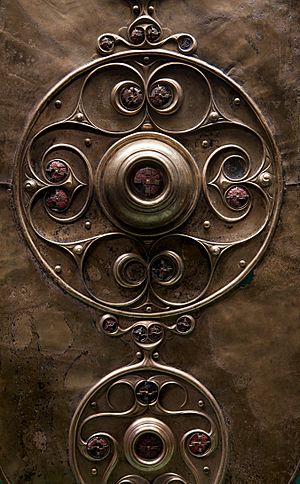Battersea Shield facts for kids
The Battersea Shield is one of the most important pieces of ancient Celtic art ever found in Britain. It is a beautiful bronze cover that once belonged to a wooden shield. This shield is decorated in a special style called La Tène style. You can see the original shield at the British Museum in London. A copy of it is also on display at the Museum of London.
Quick facts for kids Battersea Shield |
|
|---|---|

On display in the British Museum
|
|
| Material | Bronze |
| Size | Length: 77.7 cm Width: 34.1–35.7 cm Weight: 3.4 kg |
| Created | Iron Age, c.350–50 BC |
| Place | River Thames, London |
| Present location | Room 50, British Museum, London |
| Registration | 1857,0715.1 |
Contents
When Was the Battersea Shield Made?
The British Museum believes the Battersea Shield was made between about 350 BC and 50 BC. This time period is known as the British Iron Age. Some experts think it might have been made a bit later, closer to 50 BC or even the early 1st century AD.
How the Shield Was Discovered
The shield was found in 1857 in the River Thames in London. Workers were digging for a new bridge, the predecessor of Chelsea Bridge. In the same area, they found many other ancient weapons and even skeletons.
What Was the Shield Used For?
At first, some historians thought the area was a battle site. They believed it might be where Julius Caesar crossed the Thames during his invasion of Britain in 54 BC. However, most experts now think the shield was not used in battle. Instead, it was likely a votive offering. This means it was placed in the river as a gift to the gods. This offering probably happened before Caesar's invasion.
What Does the Battersea Shield Look Like?
The Battersea Shield is made from several pieces of bronze. These pieces are held together by hidden rivets. The shield is decorated with special techniques. These include repoussé (where the metal is hammered from behind to create a raised design) and engraving. It also features vitreous enamel, which is a type of colored glass fused onto the metal.
Designs and Symbols
The decoration is in the La Tène style, which is typical of ancient Celtic art. This style often uses circles and spirals. The shield has 27 small round sections made of raised bronze. These sections are filled with red enamel. Inside these bronze sections, there's a design that looks like a swastika. In ancient times, this symbol was called the "whirling sun" and was linked to good luck and solar energy.
Enamel was something the Celts were very good at making. The red enamel on this shield might have been used to copy the look of red coral. Coral was often used in other Celtic artworks, like the Witham Shield. Some people also see a hidden human face in the shield's design, especially where the smaller circles connect to the larger ones.
Was It Used in Battle?
Archaeologists say the bronze sheet of the shield is quite thin. It probably wouldn't have offered much protection in a fight. Also, there are no signs of damage from battles on the shield. Because of this, experts believe the shield was made as a "parade piece" or a symbol of high status. It was likely created specifically to be a votive offering. The bronze part we see today would have been attached to a plain shield made of wood or leather.
See also


